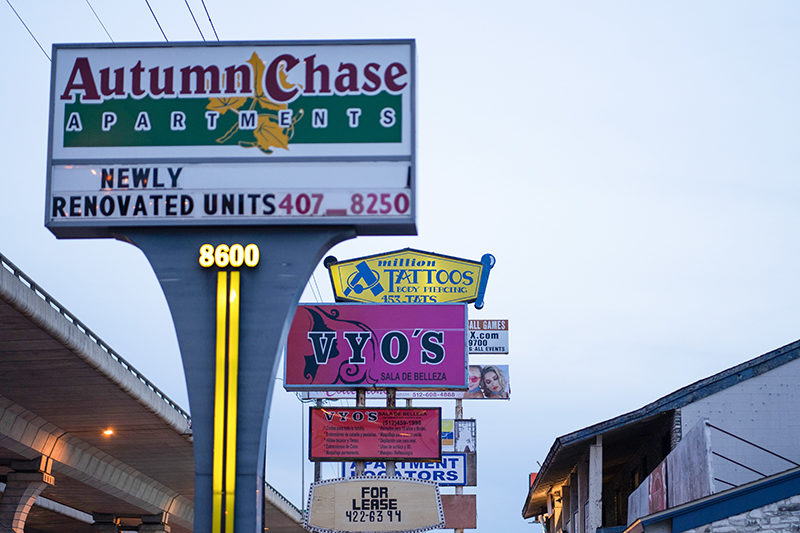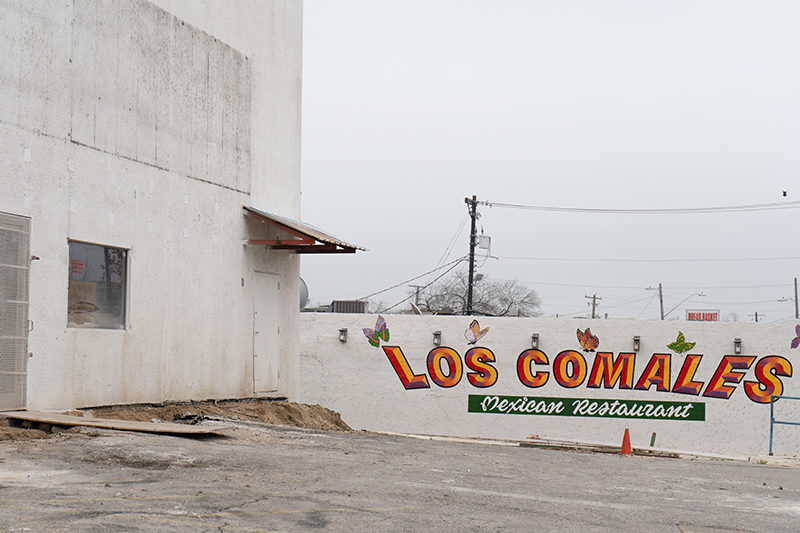North Lamar’s Long Road Toward Improvements
By Alyx Wilson
Reporting Texas

Signs advertise business and apartment vacancies on North Lamar Road in Austin. Nadia Elchmaissani/Reporting Texas
In September 2017, the Austin City Council passed a resolution that encouraged city staff to focus in “small area planning.” Small area plans would focus on land use, economic development, transportation and zoning in specified areas of the city. Matt Dugan, division manager of the Planning and Zoning department, said small area planning would allow the city to plan in a more sustainable and equitable way.
Almost two years later, the city is in the midst of developing a small area plan for what some residents consider a neglected pocket of Austin — the area around North Lamar Boulevard north of Highway 183 to Braker Lane.
Comprehensive small area planning taking place now — as is happening with the North Lamar Imagine Austin Corridor Plan Pilot — will affect Austin for generations to come: The city is still seeing the effects of the racially segregated 1928 plan that created a “negro district,” Dugan says.
City staff members are working to encourage public participation by holding a series of public meetings and hope to educate residents on city plans that are already in place, such as the Austin Strategic Mobility Plan and Strategic Housing Blueprint, that will affect future planning.
For now, small area planning efforts are again at a standstill until a rewrite of the Land Development Code, formerly known as CodeNEXT, can be approved. Dugan hopes to have a public kick-off program begin in the months following the new Land Development Code’s approval.

A warehouse sits on a section of North Lamar Road in Austin. Nadia Elchmaissani/Reporting Texas
Why focus on the North Lamar corridor?
The Austin City Council passed the Imagine Austin Plan in 2012. That plan designated nearly 20 roadways deemed vital for connecting different parts of Austin as “corridors.” The city prioritized North Lamar Boulevard as one of the first corridors in need of construction improvements.
Corridor Program Office spokesperson Kelly said that the 2016 bond totaled at $720 million for transportation improvements across the city. $482 million of that bond is going directly to the nine construction-eligible corridors, one being North Lamar.
Buthe said the bulk of construction on North Lamar Boulevard is expected to take place between 2021 and 2024. However, the city hopes to provide more immediate relief to the area with new traffic signals or enhanced pedestrian crossing signals before 2021.
What is the process?
Dugan said that staff is in the process of identifying stakeholders in the area. From neighborhoods, to renters, civic organizations and even some of the middle schools in the area, the planning and zoning department is working to get a bird’s-eye view of whose needs they are going to try and meet.
The next step, according to Dugan, is to bring the corridor plan to those stakeholders on their turf. That means that city staff will be hosting meetings in the North Lamar area to identify what the community considers necessities.
After a 14- to 16-month process of engagement, visioning, planning, and drafting, the final draft of the plan will go through an adoption plan. It’ll make its way through the necessary committees and commissions before going to council to be passed as an official city plan.
Buthe and Dugan agree that city-implemented work to improve mobility and neighborhood planning will be key in uplifting the North Lamar area as a whole.
“The ultimate goal is to bring improvements that make that corridor safer and easier to travel for everyone regardless of their mode of transportation, and regardless of their socioeconomic status,” Buthe said.
Is progress being made on the North Lamar plan?
City officials are working on the North Lamar Imagine Austin Corridor Plan Pilot, but the City Council tabled action on the pilot plan on May 9 while waiting on a Land Development Code rewrite to avoid confusion between the two efforts.
Council Member Kathie Tovo said it was a mistake to postpone the pilot plan, given the need for improvements in the area.
What do residents say?
Maria Ragan, store manager of Action Pawn in the North Lamar area, said something needs to change soon.
Ragan said that during the last five years the affordability in the area has dropped drastically and forced families to hold down two and three jobs to afford to live in the area.
Improving safety on North Lamar would have a positive impact on the area, raga added. Her biggest hope, she said, was that the city would consider adding more places for the neighborhood kids to safely play.
“There are so many kids,” Ragan said, pointing to photos of some of the adolescent customers she had on the wall of the shop, “I feel like they have to add more areas for kids to come, like a recreational [indoor] spot.”